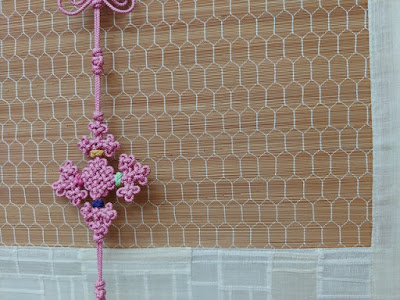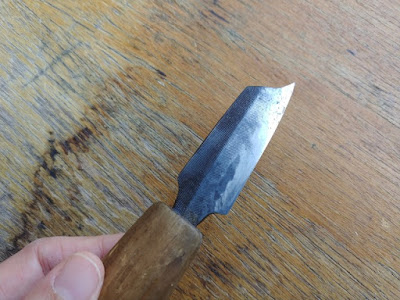I'm so happy to have a blog post with less than 50 photos! I was in a car for a lot of this trip and while I could have stuck my phone out the window to shoot while driving, I knew then Dr. Jo would insist on pulling over to let me take lots of pictures and then we'd never get home. After going to Uiryeong on April 8, the next day we went to Geoje Island to see a show of an old friend of his. We stopped before crossing the bridge to get to Geoje, in Tongyeong.
This was exciting enough, to be so close to water, but the ride there and back was stunning, it makes this view look like staring at a brick wall when your window fronts an alley. The southern sea of Korea is well known for having hundreds of tiny islands all over. As you pass, there are endless lumps of land sticking out of the water.
Dr. Jo's friend, Jo Gap-seon, has been dyeing fabric for years and she was invited by Kim Jin-hee to have a one month exhibit at Ms. Kim's Geoje gallery (Chodam Gallery). This is a bigger deal because usually artists who show in Korea pay a very high rental fee to have a one week show at a gallery, and have to provide everything that American artists sometimes take for granted (publicity, installation, reception, etc.). Of course at the higher tiers of museums, it's different, but I've always been shocked by how much work goes into shows that are so brief.
Mrs. Jo (not related to Dr. Jo—in Korea, women do not take the family name of their husbands) has also been working with her son, Chang Se-kyung, so it's a two-person show. I was so happy to see a young person doing this work, and people commented a lot about how he is able to do dyeing that requires a lot more sheer strength (dyeing entire blankets and large pieces). He's friendly with the natural dyeing folks over in Naju as well.
I was really captivated by the leather eco-printing he has been doing, and every corner of the gallery was covered with work that he and his mother have done for years. The spread was huge as well so we essentially ate lunch there.
Of course I bought a bunch of stuff here and this is my favorite activity to do when traveling: buying from other artists. I understood the flower printing but he explained the rest: lines from tape resist, and the red color from dyed cloth that was placed behind the flowers before making the print. So simple! But the way leather takes the prints is so much more vivid than anything I've seen on other material. Don't ask me what I'm going to do with it, I just had to have it.
Her scarves were so lovely, and I feel like I get to be reunited with Korean silks. Strangely enough, the scarves I brought with me to Korea all started to tear here, so it's a great excuse to stock up on more.
I can't remember who did these but I noticed right away the pieces that used bark lace.
Once you're married to a material, it's hard not to recognize it everywhere you go (it's poking out from the bottom of the intact flower.
I also loved how Ms. Kim marks sold items! The berry is so much more in line with the show than red dot stickers.
Ms. Kim (she could be married, I don't know. I'm still too American to ask these things, even though Dr. Jo always announces loudly when he introduces me to anyone that I am single, old, and that I won't get married), Mr. Chang, Mrs. Jo, and me being underdressed because guess who didn't know that I was going to be going to an art opening when I packed in a hurry two days prior?
The entire time that I was shopping and talking with the artists, Dr. Jo was furiously making phone calls on my behalf. He was trying to get a hold of the national treasure holder of bamboo blind making. His first avenue had not gotten results fast enough due to his friend's illness. So he decided to call the city itself, as Tongyeong is recognized by UNESCO as a cultural city of music and generally it prides itself on being a cultural hub. That worked, so after leaving the island to cross back to the mainland, we rushed to meet the screen maker. On the way I noticed the road signs, only because Minari has been such a huge force lately. Korea in general has been through a years-long process of renaming and re-addressing roads and homes to make it easier to get around, and I've noticed a big difference in ease of navigation.
The national treasure holder (technically intangible cultural property but I get so tired of typing that out every single time...) has two locations where he works and teaches. Today he was here, and in general I had a good feeling about the possibility of explaining to him what I needed to learn, because I knew that he already taught.Jo Dae-yong is at left and Dr. Jo at right. I'm using the distorted lens only so you can see the massive screens hanging on the walls. What you miss in this cell phone shot is the pattern on all of the screens. The red one in particular has large characters woven into it that you'd only notice from the right angle. Below is a detail of the screen behind Dr. Jo:
This was one that Mr. Jo pointed out to us because he had used shorter splints. It's hard to see here, but he staggered all of them within the pattern, which is so. much. work. He told pages and pages of history that I wrote down but still need to transcribe about screen culture in Korea and how they were used.
He took this frame out of a screen in progress so that I could practice a little, which was very kind of him given the fact that we had just kind of descended up on him. It was good to see that Dr. Jo's suggestion of simply using nuts and bolts as bobbins is totally legit! They are covered here in foil before being wrapped with thread. He had lots of student frames as well of work in progress, with similar weights.
Here he is at work, adding a long bamboo splint to the next row. This is the giant difference between bamboo screens for hanji and bamboo blinds used to hang in windows, doorways, to block the view of outsiders, and so on: the former requires that you cut out all nodes, the latter keeps the nodes to have long splints. We can't have nodes in papermaking screens because it would wreak havoc on the sheet formation process (any low or high points in the screen would make thick and thin spots in the paper).
I was really exhausted by now and tired of sitting on the floor (with age and after a few accidents, my hips get very cranky after a while, which is a shame because it used to be no problem), but I tried to practice as I was directed. I intentionally brought my computer to try and show the things I've done in the US to spread hanji knowledge and culture, and my own work. If I was really on top of things, before I left I would have designed and printed an entire booklet about my life's story to show to people here who don't read English but I continue to not have time/interest in doing so. I remain the weird old spinster traveling the country to learn obscure techniques that even the practitioners don't want to share.
We were both worn out by the end of the day and though it would have been fun to stay in Tongyeong for dinner, we had to get back to Jinju and make sure I could get another night at the guest house before leaving the next morning for Jeonju. Our last meal together was monkfish soup, though as always we had tea/coffee at the bus terminal the next morning before I left.
Because I've not been able to find a good bamboo source since the people I've met harvest and process their own, I went back to Mr. Yoo the day after I got back and met with him and his wife again. They let me take some of their stash, and we'll settle up when I pick up the final screen that I've ordered from them. You can never have too many, especially the older they get. Here he is pulling splints, which is his main job these days, I think. His wife Mrs. Seo seems to do all of the weaving and sewing.
This is the part that kills me: to make tools, you need tools, right? So even if I want to practice, there are a lot of simple looking tools that are not easy at all to source. Bamboo splitting knives are really specific and this makes me crazy because it requires getting to know blacksmiths really well. While reading an essay about hanji makers in the final dynastic period of Korea, it turns out the government employed the most people in the paper industry but guess who came in second? Blacksmiths. The way this work pools sideways makes me wonder what road I am doing down. I thought it would be an easy, contained book to write, but it has taken hold of me and will not let me go after all these years. While I wish I could say I'm 100% focused on being here, there's no real way to leave everything behind. This is the poster for the natural dye panel I'll be on with three Korean people in a few weeks. We've recorded our talks and they will be available online soon, so that you can watch them ahead of our live Zoom Q&A on May 1, for the Baltimore Natural Dye Symposium. There's an online show as well. Also, for any AAPI craft folks, there is a time-sensitive (by April 20) push to create a directory, so check here for details on participation.























No comments:
Post a Comment